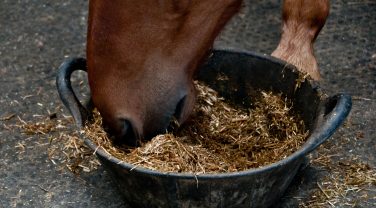Understanding Why Horses Need Protein
Why Do Horses Need Protein?
Protein is often cast as the villain, but it is actually vital for good health in your horse. Protein is found in all tissues in the body and enzymes, hormones and antibodies are also made of protein. The building blocks of protein are amino acids, some of which have to be supplied in the diet because the body cannot make sufficient quantities to meet requirements. The amino acids that must be supplied in the diet are termed essential amino acids for horses. The ‘quality’ of a protein is often measured by the levels of essential amino acids it contains. Lysine is the only amino acid for horses, essential or otherwise, for which the requirement has been determined.
What Does Lysine Do For Horses?
Lysine is an essential amino acid which means that it must be supplied in the diet. Lysine is known as a limiting amino acid. This means that whilst there can generally be an abundant amount of protein in the diet, the horse can still be protein deficient if there is insufficient lysine in the diet. Lysine for horses is particularly important for youngstock because a deficiency will limit growth and development.
Symptoms of Protein Deficiency in Horses
Generally, if enough energy is consumed, which can be identified by the horse being in good body condition, the overall amount of protein in the diet is likely to be sufficient as well. However despite adequate protein intake it is possible for a horse to still be lacking sufficient essential amino acids for horses, like lysine. This is most likely to occur in horses that have restricted grazing and forage, or possibly even for horses having soaked forage. It can also occur at times of higher demand coupled with inappropriate nutrition such as during pregnancy, lactation and growth.
Easy-to-spot symptoms of protein deficiency in horses include:
- Flagging Stamina
- Poor hoof growth
- Poor hair quality
- Loss of muscle mass
- Poor growth as identified by lower average daily gain
- Reduced milk production in lactating mares
Alfalfa As A Source Of Protein For Horses
Alfalfa is a member of the legume family, so possesses the ability to ‘fix’ nitrogen from the atmosphere and incorporate it into the plant. Along with soya, which is also a legume, alfalfa is one of the most commonly used sources of protein in horse feeds.
The key features of the protein in alfalfa are:
- Most of the protein in alfalfa is found in the leaf. In fact, the leaf contains two to three times more protein than the stem.
- The level of quality protein in alfalfa is very good, with lysine at 0.83% compared with wheat at 0.4% on a dry matter basis.
- 3kg of Alfa-A Original provides a 500kg horse in light work with 65% of its crude protein and 62% of its lysine requirement. NB: Grass and hay/haylage will usually supply the rest, so a broad-spectrum supplement is all that is needed to provide a balanced diet for most horses and ponies.
Myth Busting: Why Horses Need Protein
It has taken some time, but there is now fairly extensive research vindicating protein, which raises the question: why was protein ever thought to be the cause of so many problems. The explanation might well lie with the laws governing the nutritional information that has to be listed on every bag of horse feed.
As the level of protein has to be declared on a bag of feed and the starch level doesn’t, protein has often been used as the measure of the ‘richness’ of a feed. With traditional cereal-based compound feeds such as mixes and cubes, it usually follows that the higher the protein level, the higher the starch level, as the feed provides more energy for a higher level of work. If high protein (and starch) feeds are being fed and a problem such as laminitis or colic ensues, it is fairly understandable that protein is believed to be the cause because this is the nutrient that the horse owner knows has increased when they look at the back of the bag. Until changes to legislation are made, it is likely that some horse owners will continue to blame protein for a number of problems.
Some of the diseases and problems that protein is wrongly blamed for include:
- Laminitis – most laminitis cases results due to an underlying endocrine problem including EMS or PPID. Horses prone to laminitis need to have the amount of sugar and starch in the ration restricted, not the amount of protein.
- Muscle problems– research has shown that high-starch diets and not excessive protein intake are a contributing factor to muscle-related problems now referred to as ERS.
- Over-excitable behaviour – protein is rarely used as an energy source by the horse and over-exuberant behaviour is more likely to be caused by an increase in energy intake, of which the horse owner might not be aware. The levels of energy in grass and hay/haylage vary throughout the year and, even if the horse consumes the same amount of forage, the energy intake might still increase through ‘hidden’ energy.
Where do I get more information on protein levels in my horse’s diet?
As feed manufacturers are required to declare only the level of crude or ‘total’ protein on a bag, this doesn’t tell you much about the levels of essential amino acids for horses in the feed. Most manufacturers will be able to tell you this information if you request it directly. If you would like a personalised feeding plan for your horse, including more information on key essential amino acid for horses, please telephone the Dengie Feedline on 01621 841188 or email feeds@dengie.com.



